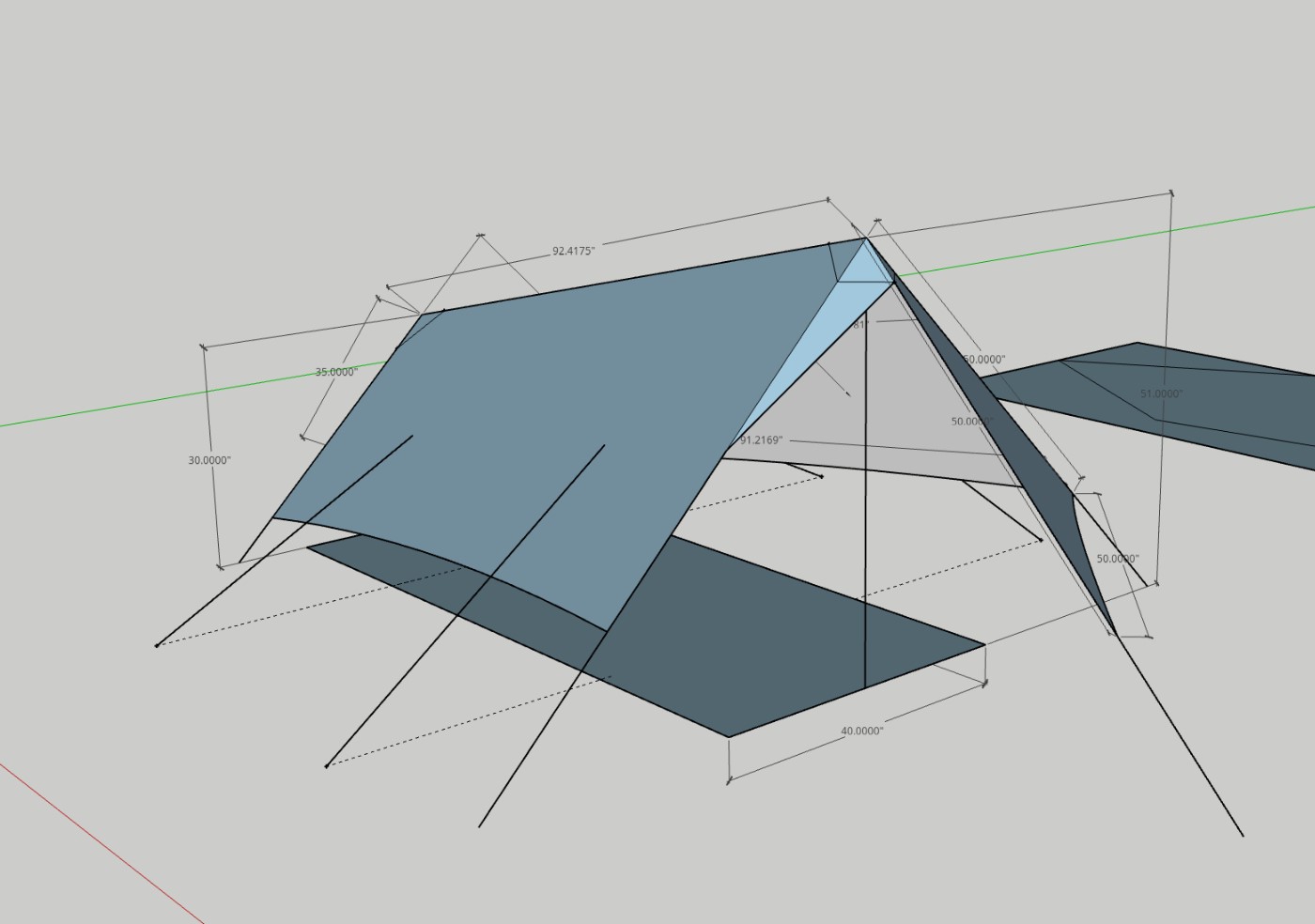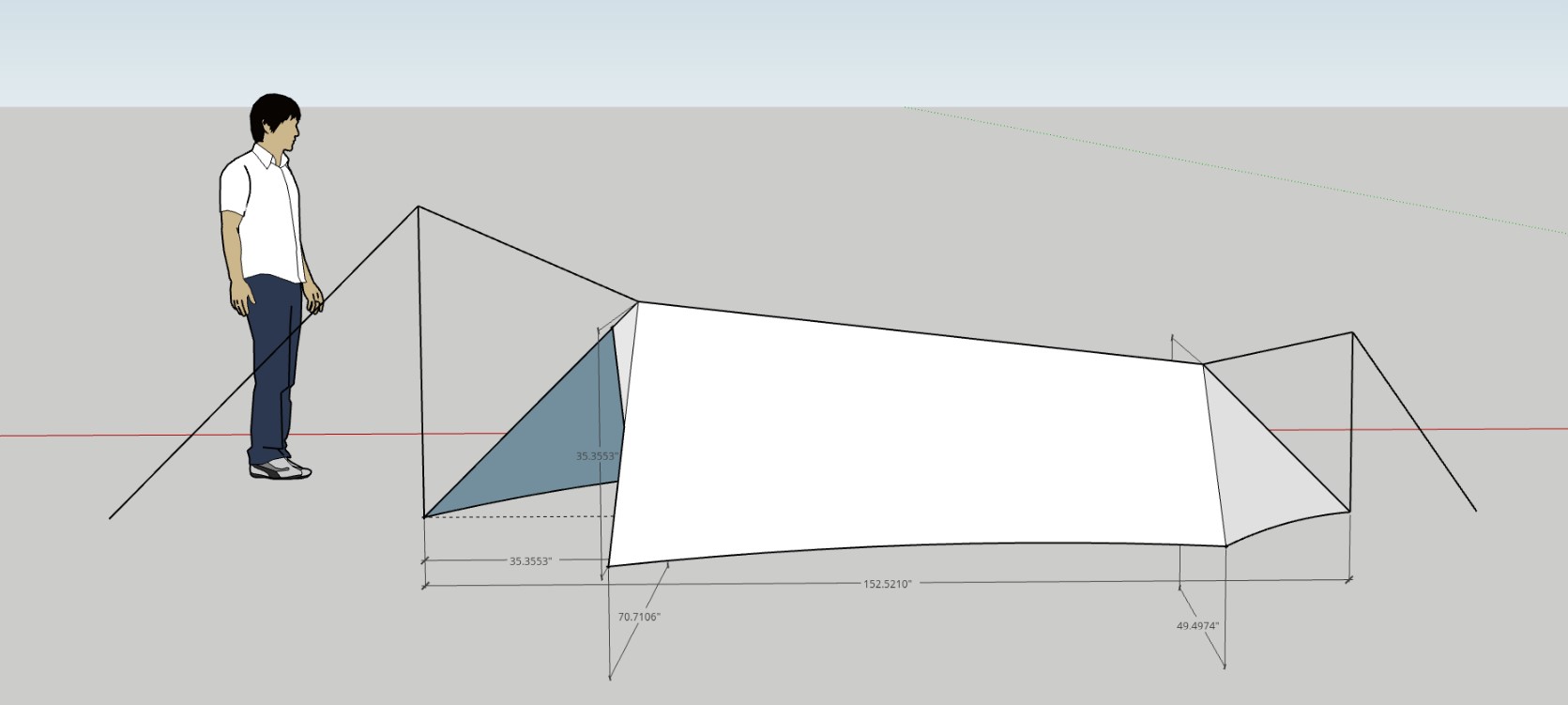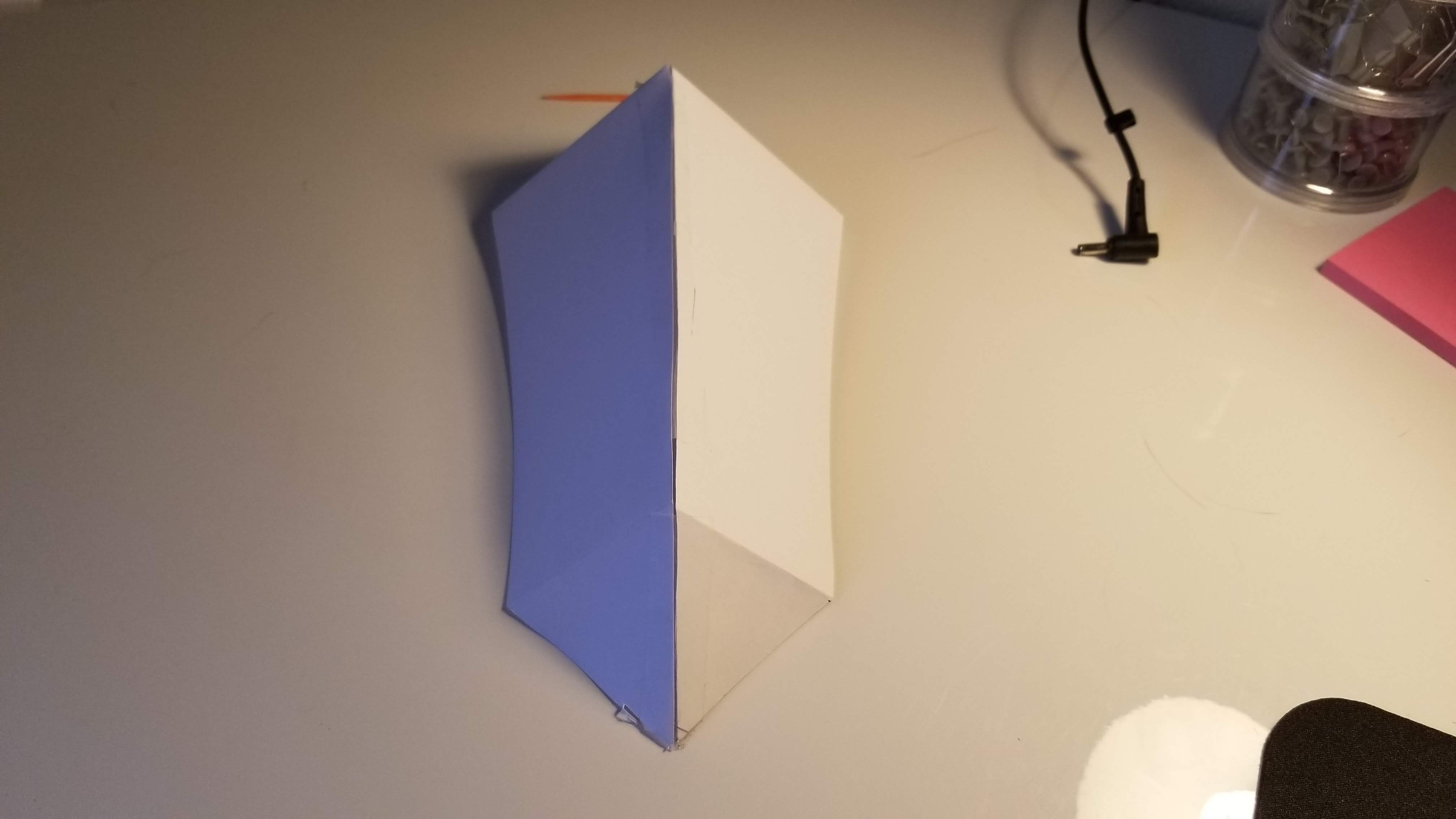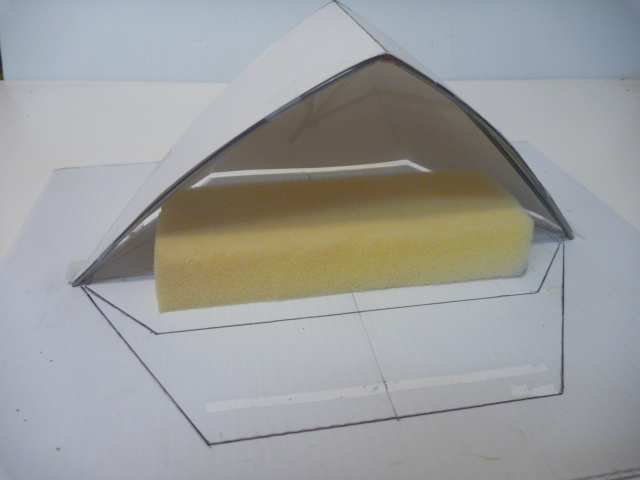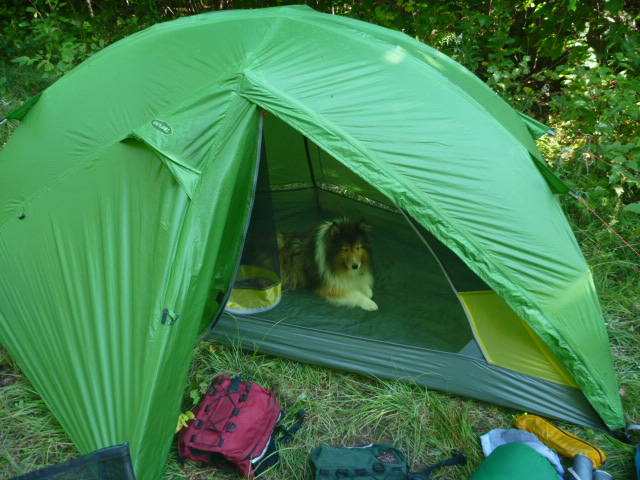Topic
Input on This Tarp/Tent Design
Forum Posting
A Membership is required to post in the forums. Login or become a member to post in the member forums!
Home › Forums › Gear Forums › Make Your Own Gear › Input on This Tarp/Tent Design
- This topic has 45 replies, 10 voices, and was last updated 5 years, 5 months ago by
 Aaron.
Aaron.
-
AuthorPosts
-
Sep 1, 2019 at 3:03 am #3608439
So I went ahead and sketched up a shaped A-Frame with a beak in the rear and the front.
Tarp in Good Weather Pitch


Tarp Pitched in Storm pitch


Cut outs from 9 yrds of fabric

I went with an equilateral triangle shape for the beaks to keep the measurements simple and cutting the fabric easy. If I cut each side of the tent as a single piece I could keep the entire tarp under 9 yrds of fabric, which is good enough for me. I modeled the tent with my 130 cm trekking pole inside the tent for good weather pitch and outside the tent too see how much room I would have with the tent pitched to the ground for the storm pitch.
This design will also be much simpler too sew as it’s really just one large seem down the middle then a rolled hem around the sides. I think I will put a zipper at the front of the tent and have a guy line run from the peak so the beak can be rolled up on either side.
With this design I’ll either start carrying a second trekking pole or pick up a 30″ pole to place at the rear. While this design uses slightly more fabric I think the massive amount of room it has over the mid pole design will be worth it.
Let me know if anyone sees any potential issues with this design, or suggestions.
EDIT: Now that I’m thinking about it I’ll probably replace the 2 guylines in the center of the side panels with 1 centered along the bottom seem of the side panels. I’m currently not planning to use this in the snow or anything.
Sep 1, 2019 at 3:39 am #3608444Also if anyone has any insight on what diameter of carbon or aluminum pole I should get that would be helpful.
Sep 1, 2019 at 5:37 am #3608465Looks great. Perhaps have zippered doors . Symmetrical ends. They would roll and store as your design looks now.
.02 cents.
Stephan
Sep 1, 2019 at 8:36 am #3608470I would use a zipper for the front porch. Short, straight zips are pretty reliable provided you don’t use the fastener to pull the fabric together as you close it. One trick – you can put a couple of fasteners at the top. If the first fastener wears out, simply lever it off and you are good to go with the spare – easy to do in the field. Roger Caffin has found a #3 reliable with care. But if you’re planning to use for 100s of nights, or in dusty deserts, I’d go for a #5 – the extra weight is trivial for a zip of this length. Moulded teeth are more reliable than coil, and less vulnerable to UV.
Instead of a second porch at the back, do consider the Paratarp idea for the rear. Fewer seams to sew, one less peg to pitch, bomber in the wind and much more versatile (you can pitch open or closed), at the cost of a slight increase in footprint. If you’re struggling to visualise how it works, here’s a video of someone pitching it. The main shape is basically an elongated trapezoid with a straight edge at the foot:
https://www.youtube.com/watch?v=clZ4KExXHUc
But don’t use the Paratarp dimensions – they’re odd – too short to sleep between the poles.
Sep 1, 2019 at 12:12 pm #3608474Justin, Yeah, a flat end is REAL handy. In good weather it acts as a rain/snow shed. In poor weather, you can seal it down on all four sides for the weight cost of a zipper. Make sure you pot a snap closure at the bottom. This will prevent you from splitting the zipper when you are setting up.
Sep 1, 2019 at 2:26 pm #3608487Interesting idea about putting a second zipper pull in, I think I’ll try that next time
I suspect the actual zipper fails in many cases though
I used a #3 zipper on a mid for maybe 30 nights. Then, it failed. The part that was supposed to be closed started opening up. I could still get it to work by unzipping and zipping again, at least for that trip. Then put in #5 zipper.
Sep 1, 2019 at 3:02 pm #3608491Justin, as far as tent poles go, for the rear pole, I use a 14″, 5mm pack stay. I replaced the ~12″x1/4″, or about 30cmx7cm. This was more than enough. Since I use a hiking staff for a front pole, I hesitate to recommend one. Mine tapers from ~5/8 down to about 3/8″ single piece. It supports most of my 180 pounds, more than enough for a pole.
Sep 1, 2019 at 10:58 pm #3608550I like the Paratarp design, but when modeling the tent I find it a bit hard to determine how high the rear peak will be since the silnylon stretches. I think It would also be easier to determine the ridge-line cat cut with the tarp designed how I have it.
As for the zipper on the front does anyone know where too find a zipper that will work for this? Ripstop by the roll sells a ykk #5 $16.95 and I’d like too keep all components under $80 (I already have seem sealer, and zing it guy-lines). Buying a coil zipper wouldn’t work because it needs to be able to separate at one end correct?
I might end up going back too a zipperless design with the two doors having 6 inches of overlap and have the doors open similar too how the zpacks hexamid doors work.
I also found that z-packs sells a collapsible 32″ carbon poll for $15 so I might pick that up for the rear pole.
I also made a paper model too see if my angles measured from the model are correct and it seems work out!

 Sep 1, 2019 at 11:33 pm #3608555
Sep 1, 2019 at 11:33 pm #3608555you could use zipper by the yard from local fabric store
I don’t think you need a separating zipper, that would be like a jacket
$0.45 per foot plus $0.25 for a pull at RSBTR
Sep 1, 2019 at 11:56 pm #3608557Jerry, do you know how I would make the zipper stop at the end that separates? Could I just wrap the teeth in a piece of grosgrain on each side so the slide stops at the ribbon. Like in this picture? Or is there a better way to do it?

Sorry if this is a basic question I’ve never sewn a zipper that separates at one end before.
At the top of the zipper I know I can sew through the zipper at the seam to create a stop but I’m unsure how to do it at the other end.
Sep 2, 2019 at 10:01 am #3608585You use a zipper stop, like this:
Sep 2, 2019 at 2:07 pm #3608598I’ve never got one of those zipper stops to work
Whip a bunch of loops of thread works, you need a bunch
The last time I did that I didn’t do enough and the zipper pull came off and I had a heck of a time getting it back on. Then I put a dab of epoxy.
Sep 2, 2019 at 6:00 pm #3608641That’s what I do, just dab it with a glob of epoxy.
Sep 2, 2019 at 6:54 pm #3608644I’m not experienced in MYOG but I’d rather have this tarp with overlapping doors than a zipper. I like the simplicity and reduction of weight.
Sep 2, 2019 at 7:44 pm #3608647zippers aren’t very heavy, probably fabric overlap would weigh (insignificantly) more
But, in my experience, they do fail. overlap would be better in that regard. And I’ve had water freeze into the zipper making it impossible to unzip.
You could sew a few ties on either side of the zipper and use those if the zipper failed
Sep 3, 2019 at 4:21 am #3608715Returning to an issue expressed early in the thread – foot and headroom – am glad that Franco’s post shows how cramped a tarp tent can be. For adequate space inside, It is necessary to raise the roof and widen the tent considerably if the tarp is to be pitched with a side entry. That’s a fair amount of increase in the fabric area, creating a fair amount of increase in weight overall.
It may be helpful to think of an A-Frame as any shape where unsupported walls drape from the top down to the bottom in a straight line. This helps to see why a tent like the Fly Creek design really adds little space inside compared to a conventional A-frame.
Using scale models can also save a lot of work to get a handle on how cramped or spacious a tent will be. Bought a doll at a dollar store labeled, “Girl on the Beach.” It was almost exactly 6 inches long, or 6 feet using a scale of 1″ to the foot. Her head was a little overlarge compared to the feet, but provided a good idea of how spacious a structure would be inside. Closed cell foam comes in many thicknesses, and can provide a good scale model sleeping pad. Here, a 6″ long foam block was used, but that was before the doll was purchased and revealed more internal space – even on the scaled pad, there was lots of space for the doll’s head and feet, not to mention space to sit up and move around:

Note that the use of a minimal frame bows the walls out, while a flat A-shaped wall would bow the walls in due to catenary cut. A big difference in space.
Nevertheless, there is a clear trend to tarp tents using a trekking pole, or poles, presumably to save weight; but wonder how much weight is really saved considering the greater fabric area required to provide adequate internal space, and the lightness of a frame of poles of flexible carbon tube that weigh under 1/4 ounce per running foot. Am wondering about several other questions. If weight is saved by using trekking poles, is it enough to justify the decreased space? And does the trekking pole really provide more wind resistance and stability than a flexible carbon frame? Or is the simplicity of making a tarp tent with A-shaped walls really the chief motivating factor in MYOG?
Sep 3, 2019 at 6:29 am #3608725there is a clear trend to tarp tents using a trekking pole, or poles,
The trend has been going on for at least 20 years. Jardine never advocated trekking poles in the PCT Hiker’s Handbook (he recommended trees or sticks you pick up on the trail), but his tarp designs lent themselves to them perfectly. Shires’ original tarp tent was an A-frame in the same mold. If you’re carrying trekking poles, there’s no debate in my mind, A trekking pole will never bend or break while being used as a shelter pole. Ultralight tent poles do bend and break. The real debate his how useful trekking poles are as trekking poles. I’ve hiked thousands of miles with them and without them, and for me it’s a toss up. On a long hike they keep my arms in shape – that’s the most noticeable benefit I’ve encountered. They seem like they’re helping my knees on steep downhills, but I don’t have any conclusive evidence one way or the other.
You seem to be arguing tarps vs more traditional tents, not about poles. A tarp or minimalist tarp tent is just a different experience from a framed tent, apart from any weight or space differences. Usually a tarp style shelter can be pitched in different ways depending on conditions. The walls of an A-frame can be staked straight to the ground or several feet above it for ventilation; spread almost flat or pitched steep, etc. Most importantly for some, a tarp keeps you more connected to the outside vs being sealed up. I’ve weathered severe thunderstorms under tarps while watching the storm in full view through my front door. If I hear a noise I can see under all sides of my tarp to observe some weird deer licking the tree next to me, or a mouse chewing through my guy lines, etc. Try that in a dome tent. If you’ve got a tiny sub 1 lb tarp, naturally it’s going to be more cramped (the original side entry design Justin posted was tiny), but tarps can be huge, and still relatively lightweight for the size. The bigger a framed tent gets, the longer and heavier the poles get.
Sep 3, 2019 at 11:24 am #3608735Aaron, Trekking poles are designed to be, well, trekking poles. They need to support you and your body. But I have found them to be almost worthless in level conditions. Up hills, they help. Your overall balance is improved, but more importantly, they allow the use of your arms to push you up. For lower blowdowns, rocks and stuff, it is really helpful, even on level ground. Down hill they reduce impact on knees (and the rest of your body: back, hips and shoulders/collar bones), by at least the weight of your backpack. Again, they are only used as tent poles, allowing some dual use.
Yes, framed tents always have a proportion of the weight dedicated to the frame, just for holding materials up. No real dual use possible. Tarps, and other shelters that use trekking poles, are usually more flexible in height, also. In other configurations, a simple A frame, shed, parachute pitches, flat, lean-to, etc a tarp can really be versatile. A shaped tarp, such as Tarptent, is less flexible, but also saves a lot of weight simply by being less flexible…a single, optimized setup. A full 9’x11′ can weigh close to 17 oz A shaped tarp will save about 3.5yd of fabric weighing in at 13.5oz (assuming 1.5oz/yd.fabric.) Adding guylines and stakes brings you back to 17oz.
Sep 3, 2019 at 6:28 pm #3608790I understand the theory and marketing behind trekking poles, and I’m sure the topic has been exhaustively debated here before. In my personal experience I’m just not sure how much better my knees have fared with them over the long haul. They’re good for balance if you’re crossing a boulder or scree field, fording a deep stream, etc. When I’ve used them in recent years, I carry the lightest and shortest I can find and make sure they can collapse inside my backpack when I need to get them out of the way. In that way they can be triple use if I feel the need to add more frame support to my pack.
I once cut the handle off an old trekking pole and used it as a dedicated tarp pole. I have yet to find any form of telescoping pole that works better for holding up a shelter than a trekking pole.
Sep 7, 2019 at 5:41 am #3609288“The real debate his how useful trekking poles are as trekking poles.”
Did you mean tent poles for one of the two references to trekking poles?“I’m just not sure how much better my knees have fared with them [trekking poles]”
It depends on whose knees are trekking. Some folks greatly depend on them.“You seem to be arguing tarps vs more traditional tents, …”
Not arguing, just raising some questions about carrying two trekking poles to support a tent, when only one trekking pole is needed for hiking, and the tent may be framed with carbon with no appreciable weight penalty. It may become a question of whether two trekking poles or a carbon frame provide better support and wind resistance, especially if the weight of additional pegs are factored in for the ‘tarptent,’ to use the OP’s term.I used tarps, configured into tent shapes, for several summers as a trip leader, and used them again later when backpacking longer distances, solo or with friends. They may work fine for the hardiest souls (as would a bivy also); but I and others found it much easier to stay dry and comfy with a more spacious tent, so long as it could compete with a tarp weight-wise, which is becoming increasingly feasible with newer materials.
Dual use is great concept, and use it whenever I can, but have found that adequate shelter is more important. Our moderator regularly sounds that theme when he refers readers regularly to his BPL article, “When things go wrong.” You may be AOK with tarps, especially on the Pacific Crest, but in my experience that is not so for many, including my dog:

Granted, it is a lot easier to get up and head out for another day tramping in the pouring rain when protected only by a single wall tarp.
Sep 7, 2019 at 8:45 am #3609296I have nothing negative to say about a good tent. I knew hikers on the PCT who used tents every night no matter the weather just because they were comfortable and bug proof. I’ve tried various tent and tarp setups in a range of conditions and I see the appeal of both. I wouldn’t try to convert anyone any which way. Tarps tend to be more challenging, but with some experience they’re more than adequate for 3 seasons The wettest I’ve ever been was in a single wall free standing “mountaineering tent” (Black Diamond) that was absolutely soaked through and weeping after days of continuous rain. A simple silnylon backup tarp would have worked wonders in that situation. I agree you can’t beat a good double wall tent for absolute comfort, but a well pitched tarp + net tent is in the same ballpark for me.
-
AuthorPosts
- You must be logged in to reply to this topic.
Forum Posting
A Membership is required to post in the forums. Login or become a member to post in the member forums!
Our Community Posts are Moderated
Backpacking Light community posts are moderated and here to foster helpful and positive discussions about lightweight backpacking. Please be mindful of our values and boundaries and review our Community Guidelines prior to posting.
Get the Newsletter
Gear Research & Discovery Tools
- Browse our curated Gear Shop
- See the latest Gear Deals and Sales
- Our Recommendations
- Search for Gear on Sale with the Gear Finder
- Used Gear Swap
- Member Gear Reviews and BPL Gear Review Articles
- Browse by Gear Type or Brand.


